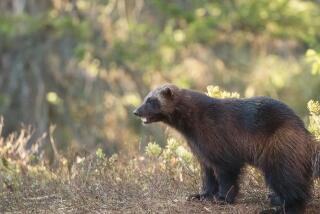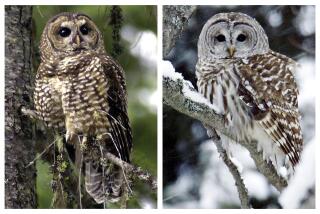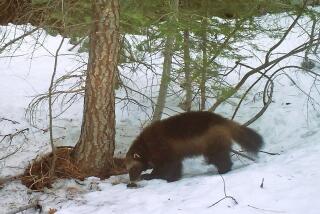More than 550 wolves taken by hunters and trappers in Rockies
SEATTLE — Wildlife managers are calling it an ecological success story. Conservation advocates say it threatens to undermine years of work to recover a once-endangered species.
The debate: A total of 553 wolves that have been killed by hunters and trappers in the Northern Rockies this season, the second since hunting of the furtive predators was made legal.
An additional 216 wolves were killed by federal Wildlife Services agents, largely to prevent ongoing conflicts with livestock.
Figures are trickling in as hunting seasons wind down in Montana, Idaho and Wyoming, where wolves were hunted to extinction in the last century but, in the wake of a controversial reintroduction program, are now ensconced in all three states and busting out toward Washington, Oregon and California.
State wildlife officials, fearing the recovery has been too robust, have been encouraging hunters and trappers to shave the numbers back, and the latest figures show that effort has worked, with 225 wolves killed in Montana, 69 in Wyoming and 259 in Idaho.
“Is that a healthy number? No, that’s persecution at an incredible level,” said Marc Cooke, spokesman for an advocacy group, Wolves of the Rockies, in Stevensville, Mont.
But state wildlife officials say they are maintaining healthy wolf populations in all three states and cannot ask citizens to put up with more.
“We need to achieve a reduction. Montana has made room for wolves, we are long past the period of recovering wolves, and we are committed to managing for a recovered population,” said Jeff Hagener, director of the Montana Department of Fish, Wildlife & Parks. “The best news is that hunters and trappers, the core of Montana’s wildlife conservation program, are helping us manage Montana’s most recently recovered native species.”
Montana’s wolf “harvest” was up 36% this year, including four radio-collared wolves from Yellowstone National Park shot by hunters. The deaths of the four prompted a national outcry. Gov. Steve Bullock last month signed into law legislation that will open the door to even more hunting, lowering license fees for nonresidents, reducing the five-day wait for hunters obtaining new licenses, and allowing the use of electronic calls to lure the animals.
Idaho’s hunt was down slightly compared with the 379 wolves killed last season, but hunting remains open in two areas of the state through June.
“The numbers are down a little bit, but I don’t think that’s too much of a surprise,” said Mike Keckler, spokesman for the Idaho Department of Fish and Game. “Wolves, they get wise fast, and I think they realized that being around humans was probably not a good idea, so they became a little more difficult.”
“As I heard one of our biologists say,” he added, “the smarter ones survive, the more naive ones tend not to.”
Wyoming got a late start on managing a hunt because federal protections for wolves in that state were the last to be lifted, in September. Its program calls for a controlled “trophy hunt” of up to 52 wolves in the northwestern part of the state, near Yellowstone and Grand Teton national parks. So far, 43 wolves have been killed.
Except for a limited “flex area” along the western border, where another controlled trophy hunt is allowed, the rest of Wyoming is open all year for wolf hunting; a total of 26 wolves have been killed so far in those uncontrolled areas.
A coalition of conservation groups has filed suit in federal court challenging Wyoming’s relatively lax hunting restrictions, seeking to have wolves returned to federal Endangered Species Act protections.
“This allows wolves in 85% of the state to be shot on sight as predators,” said Michael Garrity, executive director of Alliance for the Wild Rockies, a plaintiff in the suit.
Overall, he said, the number of wolves being shot and trapped across all three states threatens the ability to maintain a viable, connected population — a goal that many biologists believe would require 2,000 to 5,000 wolves spread across about 500 packs.
At its last official count in December 2011, the U.S. Fish and Wildlife Service said the Northern Rockies was home to at least 1,774 wolves in about 287 packs, up 3% from the previous year. New puppies in the spring added to those numbers before this season’s hunts began.
Cooke, of Wolves of the Rockies, said the actual numbers of wolves killed is even higher, when animals killed by ranchers, disease, car collisions, trains and fights with other animals are factored in.
“When you do the math, we’re coming out with more than 350 wolves killed this year, just in Montana,” he said. “I think we’re on the road to re-listing wolves in the Rocky Mountains.”
U.S. Wildlife Services spokeswoman Carol Bannerman said the agency killed 216 wolves in all three states that had come into repeated conflict with people or livestock during 2012. Idaho officials said state game officials there removed 16 more, while 21 wolves died because of other reasons.
Suzanne Stone of the group Defenders of Wildlife in Idaho said that the number of livestock attacks in that state is up significantly — an ironic consequence, she said, of the heavy hunting numbers over the last two years.
“The hunting has put such intense pressure on the packs, they’re dispersing, they’re disrupted, the packs have been broken apart. There’s a lot of younger, less experienced animals out there, and you’re not allowing the wolves to maintain a healthy equilibrium with their habitat,” Stone said.
[For the Record, 9:56 a.m. March 7: An earlier version of this post identified the spokeswoman for the Defenders of Wildlife as Lynne Stone. Her name is Suzanne Stone.]
ALSO:
Portland man charged in aiding suicide bomber in Pakistan
Civil rights group warns of rising danger from extreme right
South Dakota’s Pine Ridge tribe is a ‘breaking point’ over alcohol
More to Read
Sign up for Essential California
The most important California stories and recommendations in your inbox every morning.
You may occasionally receive promotional content from the Los Angeles Times.










